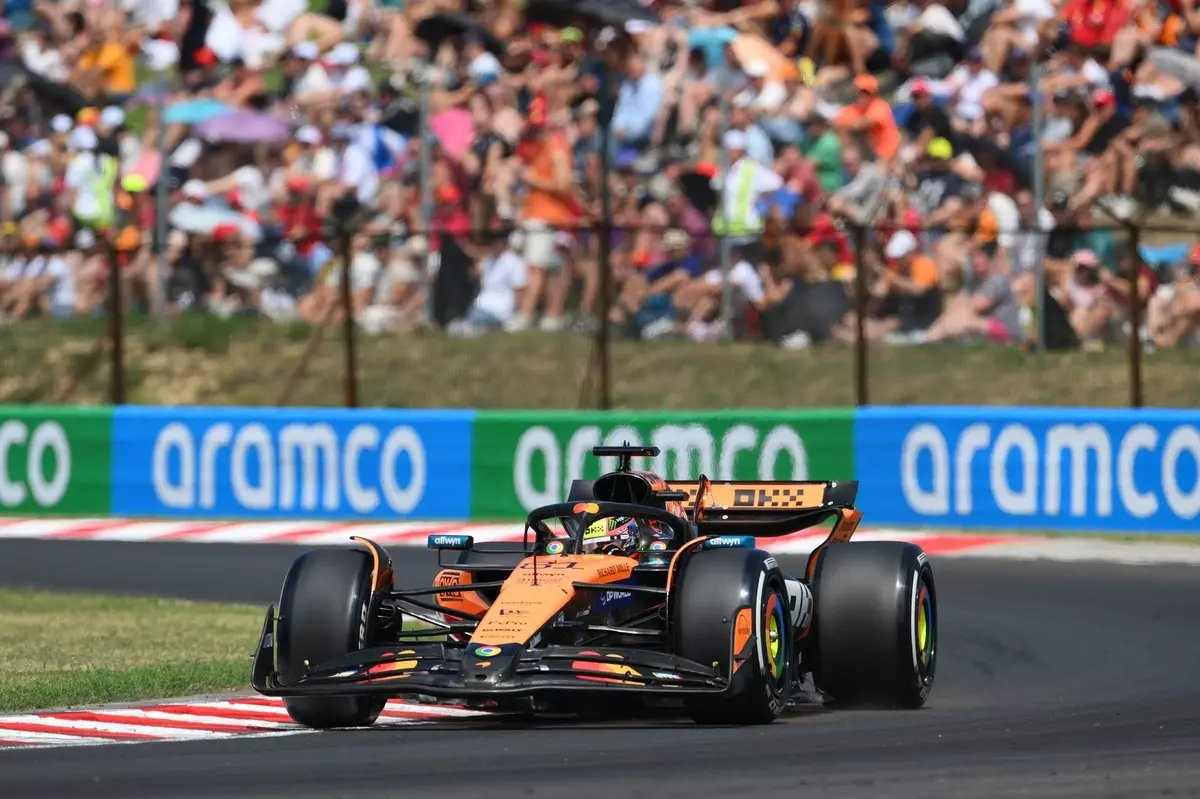The Hungarian Grand Prix’s final practice session marked a seismic shift in the dynamics of Formula 1, primarily spotlighting McLaren’s extraordinary performance. Oscar Piastri’s jaw-dropping lap of 1m14.916s not only set a new benchmark for the session but also signaled that McLaren is stepping into a new era of competitiveness. While Lando Norris followed closely, their combined aggression and precision signaled that McLaren isn’t merely participating—it’s challenging the established order. This session revealed that McLaren is subtly redefining what’s possible, breaking away from traditional dominance by Red Bull or Ferrari, and establishing themselves as genuine contenders.
The remarkable aspect of McLaren’s performance isn’t solely the raw pace but the strategic execution. Piastri’s decision to switch to fresh soft tires in the final moments exemplifies an aggressive, forward-thinking approach that capitalized on track conditions. It was a calculated gamble that paid off handsomely, propelling him into a realm where few drivers have tread this season. This performance suggests factor that McLaren’s engineering and strategic departments have matured, enabling the team to push boundaries without hesitation. If consistency follows this initial promise, McLaren could redefine the championship’s narrative, making the upcoming races unpredictable and exciting.
Redefining the Norms of Practice and Qualifying
The session was characterized by early caution giving way to rapid pace and competitive tension. Drivers initially hesitated, easing into their runs, but as the track warmed and grip improved, the real contenders emerged. The rapid progression from initial slow laps to scorching hot laps was revealing: teams are pushing their limits more aggressively, signaling a shift in how practice sessions are approached. Notably, Verstappen’s 1m16.547s on softs demonstrated that Red Bull remains formidable, yet the gap between Verstappen and Piastri illustrates that the traditional hierarchy is being challenged.
What stands out here is the strategic diversity among teams. Ferrari’s Charles Leclerc, often reliable but limited in this session, continued to hover in third place, trailing the top duo but demonstrating consistency. Meanwhile, Mercedes’ George Russell and Lewis Hamilton kept themselves within striking distance, suggesting that the German team is slowly closing the gap, despite struggles earlier in the season. The race for pole position and grid advantage is intensifying—not only because of raw lap times but also due to how teams are strategically deploying tires and managing their drivers’ runs.
Interestingly, the session revealed an emerging trend: entering the final laps with fresh tires yields the most dramatic results. Piastri’s decision to switch for a final soft-tyre run underlines an evolving understanding of optimal timing. The best times came late, after most teams had thrown everything into the mix—highlighting that day-to-day, lap-to-lap strategic decisions are becoming more critical than ever.
The Battle for Supremacy and the Surprising Underdogs
While McLaren stole the show, the session underscored the shifting landscape of competitiveness. Mercedes, Ferrari, and even Aston Martin showed they can challenge the pace—creating a competitive environment that could lead to unpredictable qualifying. Fernando Alonso’s sixth-place effort, nestled between Mercedes’ drivers, indicates that Aston Martin isn’t content with just being a mid-field presence; they’re hinting at a potential spoiler in the fight for top positions.
What’s particularly noteworthy is the performance of Sauber and Nico Hulkenberg, completing the top 10. This signals a potential renaissance for smaller teams, who are gradually closing the gap with the big guns. If this trend continues, F1 could witness a more competitive season, with surprises at the front and a more dynamic race for points and podiums. The days of a predictable top five might soon give way to a more fractured, exciting grid where contenders can emerge from unexpected places.
The struggle of Red Bull’s second driver, Yuki Tsunoda, who finished 19th, shines a light on how even the most dominant teams face internal struggles—balancing car setup, driver adaptation, and tire management. Red Bull’s overall struggles with balance reflect that excellence isn’t static; it requires ongoing fine-tuning, and other teams are increasingly capitalizing on these vulnerabilities.
This session was more than just a technical showcase—it was an ideological statement. McLaren’s breakthrough not only challenges teams to elevate their performance but also injects a renewed sense of unpredictability and excitement into the championship. As the grid gears up for qualifying, one thing is clear: the fight for supremacy in F1 is no longer monopolized by a few. Expect fireworks when the lights go out, with McLaren at the forefront of a power shift that could elevate the sport into a new era of fierce, exhilarating competition.

